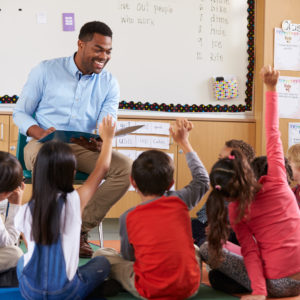In almost every sci-fi movie, there’s a scene where an intrepid crew of ragtag misfits must band together to overcome a more powerful enemy.
Just when things look lost, our heroes dream up an ingenious scheme to escape the evil empire’s tractor beam and triumph over impossible odds. The audience heaves a sigh of relief as the credits roll and rides the adrenaline rush out of the theater, with no time to scrutinize the tactical maneuverings on display or to wonder if they’ll be used to train the next generation of pilots.
Public education is subject to similar dynamics.
For too long, the tractor beam of laws, contracts, bureaucracy, local politics, big-footed vendors and mediocre training has held teachers and leaders frozen in place.
Yet, with the COVID-19 crisis upending familiar arrangements, the tractor beam is flickering, presenting a host of new possibilities for an engaged audience to learn from. It would be a tragic loss if this situation for learning, reinventing, and reimagining were to pass with nothing more to show for it than a sigh of relief and a trek past some empty popcorn containers.
American education just hasn’t done a very good job of understanding why some things work or what to make of that.
While school systems do a pretty fair job of tracking reading scores, math scores and graduation rates, for instance, there’s been far less attention paid to determining what adults did that produced those results.
Rather, school systems and researchers alike tend to focus on the final results, with a lot of assumptions and vague appeals for teachers to work harder and teach better.
This disconnect is a product of habit, incentives and time. District leaders have been trained in certain routines, are under strong pressure to move measured results, and are in a constant race against the school year.
Meanwhile, researchers have deep training in a particular kind of analysis and are under intense pressure to publish their results and land new grants, so they tend to focus on finding some noteworthy statistical findings that enable them to keep moving onto the next thing.
This has contributed to schools and a research community where self-reflection is rarely approached as a meaningful tool of self-improvement.
Schools’ improvement suffers as well-meaning reformers often serially turn their attention to the next promising solution, while blaming recurring disappointments on implementation problems and outside interference.
The result is that the habits, routines, and constraints which stymie progress and hinder each new reform can go largely unremarked and unaddressed, year after year and decade after decade. As a consequence, when results fail to materialize, leaders tend to blame “fidelity of implementation” and simply move on to the next product or reform.
Today, however, things have changed so starkly due to COVID-19 that the problems with these familiar protocols and shibboleths are glaringly apparent. This is a time for change, for both practitioners and academics to embrace the opportunity to learn from our current experience.
What, then, can both researchers and school districts do in the immediate- and long-term to gather and analyze information that will enable us to glean the important lessons from our current situation?
The first step is adopting a new mindset, one more interested in determining how our plucky rebels succeeded and less in recounting the cool special effects or happy outcome of the battle.
Such a problem-solving mindset would involve funding and support for agile research that responds to real-life dynamics and scholarly outlets that reward this kind of work.
There’s a lot that scholars can do right now to help support schools in meeting the challenges of COVID-19. Schools sorely need to design, administer, and analyze regular surveys of students and families about what’s actually going on in terms of virtual access, study routines, emotional well-being, social behavior and more.
They need to understand what teachers are actually doing, how (and how often) they’re connecting with students, and what’s working and why. And there are profound opportunities to collect and analyze data around attendance, computer behavior, and more. Scholars could be of enormous assistance in executing all this, even if it pulls them away from their narrow specialties.
Along the way, there’s an immense amount to be learned. Do some high school students, or even most, prefer a hybrid or virtual approach? How big is the imposition of virtual learning on families with children in the early grades?
Are there some subjects that work better online than others, or some teaching practices that translate especially well to a remote setting?
The answer to these questions could matter mightily both for improving schools and for leap-frogging our understanding of teaching, learning, and virtual education. Yet, few districts are set up to move on any of this and few scholars have the incentive or relationships to enter into this work. As a consequence, a remarkable opportunity for improvement and learning is being lost.
Schools are facing enormous challenges.
And yet those very challenges could make this a moment when educators and scholars have a remarkable opportunity to escape that tractor beam — and make sure the lessons they learn in doing so aren’t lost.

